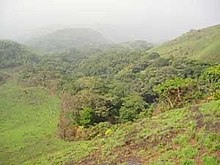Guineo-Congolian region
The Guineo-Congolian region is a
Description

The Guineo-Congolian region is a tropical, lowland rain forest area, typified by the forests of the
The floras of the Guineo-Congolian region and the adjoining
Subdivisions

Several forest types can be distinguished. Hygrophilous coastal evergreen forests occur in moist locations between Sierra Leone and Gabon in an intermittent coastal strip; these forests are often rich in legume family species which may regenerate freely and form pure stands. Mixed moist semi-evergreen forests occur extensively, especially in the Congo Basin, in somewhat drier locations. Drier peripheral semi-evergreen forest border the mixed moist forests to north and south and are subject to fire damage from adjoining savanna regions. Monospecific forests occur as patches in evergreen or semi-evergreen forests in the Congo Basin. Gallery forests and swamp forests occur where conditions are suitable but have more open canopies. Short forest and scrub forest occur on rocky hills and areas with thin soils.[1]
Floristic provinces

- The Côte d'Ivoire and Ghana to Togo in the east, and a few hundred kilometres inland from the Atlantic coast. A few enclaves of montane forest lie further inland in the mountains of central Guinea and central Togo and Benin.[5] The Upper Guinean forests are bounded on the east by the Dahomey Gap, a region of Ghana and Benin where the drier forest-savanna mosaic extends all the way to the coast, separating the Upper Guinean and Lower Guinean forest blocs.[6]
- The Nigerian-Cameroonian province, also known as the Lower Guinean forests, extend through portions of Togo, Nigeria, and Cameroon, from the Dahomey Gap to the Sanaga River in Cameroon.[7]
- The Congolian province, which extends along the Atlantic coast from the Sanaga River to the mouth of the Congo River, and east across the central Congo Basin.
See also
References
- ^ ISBN 978-1-919833-65-1.
- ^ a b "Tropical rain forest". Africa: Global Ecological Zones. FAO. Retrieved 28 June 2019.
- S2CID 85651683.
- )
- ^ "Guinean moist forests". World Wide Fund for Nature. Archived from the original on 3 November 2016. Retrieved 29 June 2019.
- ^ Linder, H. Peter, Helen M. de Klerk Julia Born et al. (2012). "The partitioning of Africa: statistically defined biogeographical regions in sub‐Saharan Africa". Journal of Biogeography Volume 39, Issue 7 May 2012. [1]
- ^ Linder, H. Peter, Helen M. de Klerk Julia Born et al. (2012). "The partitioning of Africa: statistically defined biogeographical regions in sub‐Saharan Africa". Journal of Biogeography Volume 39, Issue 7 May 2012. [2]
